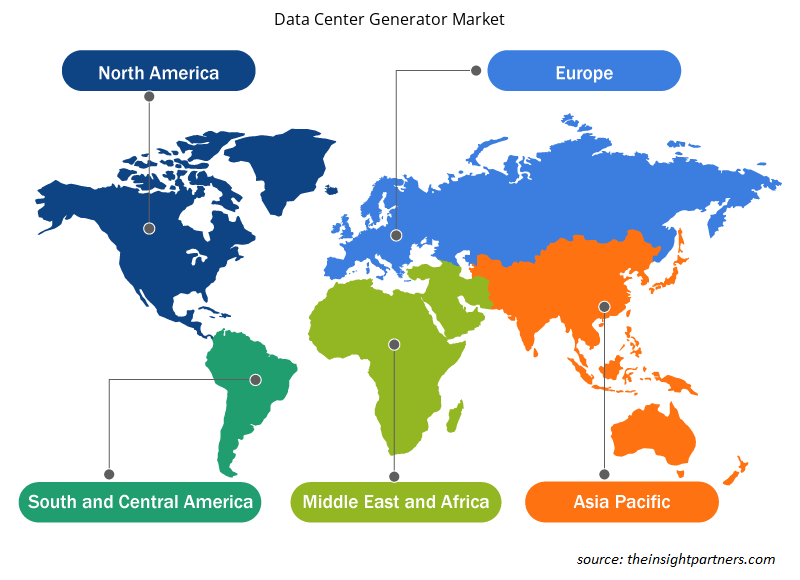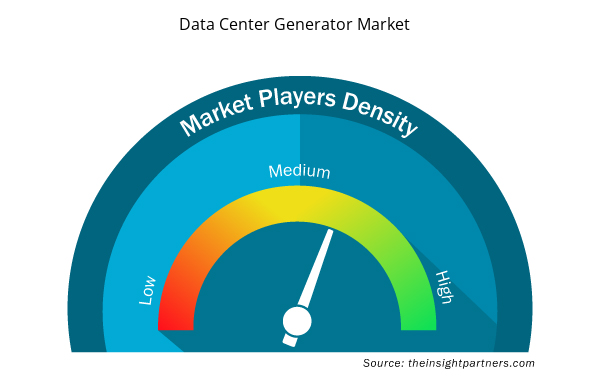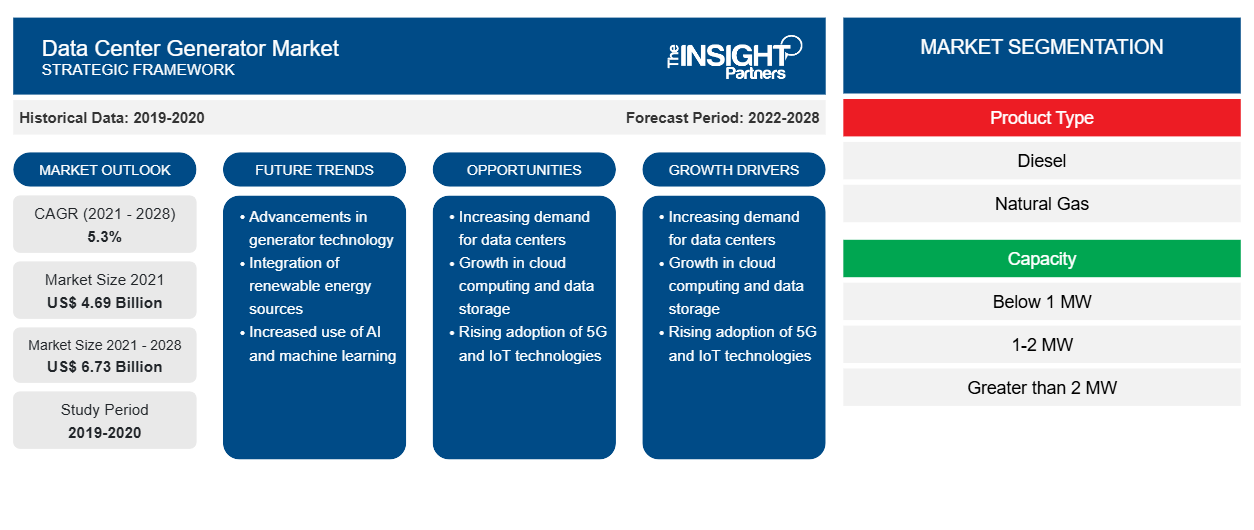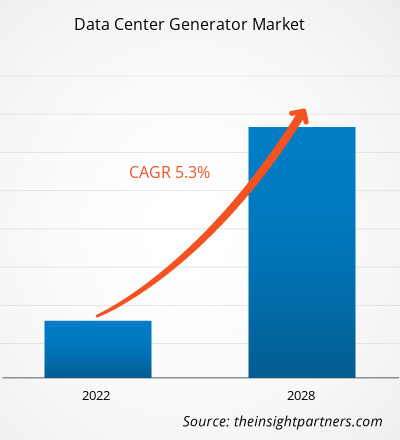[Forschungsbericht] Der Markt für Generatoren für Rechenzentren wurde im Jahr 2021 auf 4.693,00 Millionen US-Dollar geschätzt und soll bis 2028 6.729,53 Millionen US-Dollar erreichen; es wird geschätzt, dass er von 2021 bis 2028 eine durchschnittliche jährliche Wachstumsrate von 5,3 % verzeichnet.
Generatoren dienen Rechenzentren während eines Stromausfalls als Reservestromversorgung. Ein vollständiger Stromausfall in einem Rechenzentrum kann einen Systemneustart erforderlich machen, was zu Systemausfällen, Startschwierigkeiten und Datenverlust führt. Daher werden Rechenzentren immer durch eine Reservestromversorgung durch Generatoren unterstützt, um solche Anomalien und Ausfälle zu vermeiden. Solche Vorteile treiben das Wachstum des Marktes für Generatoren für Rechenzentren voran.
Diese Generatoren benötigen für ihren Betrieb keine vorhandene Stromversorgung, was ein wichtiges treibendes Element für den Markt ist. Darüber hinaus fertigen namhafte Hersteller Generatoren mit individueller Kapazität als Reaktion auf sich ändernde Kundenanforderungen. Solche Systeme können je nach Strombedarf des Rechenzentrums nach oben und unten skaliert werden. Diese Anpassungsfähigkeit dürfte die Nachfrage nach Generatoren für Rechenzentren erhöhen und damit das Marktwachstum ankurbeln. Mehrere Cloud-Dienstleister haben ihre Produktion aufgrund der steigenden Nachfrage nach Edge-Rechenzentren weltweit gesteigert. Google beispielsweise hat 2019 3,3 Milliarden US-Dollar ausgegeben, um seine Rechenzentrumspräsenz in Europa auszubauen. Darüber hinaus dürfte der Markt von der verstärkten Entwicklung von Hyperscale-Anlagen und der zunehmenden Implementierung von Diesel-Rotations-Unterbrechungsfreien Stromversorgungen (DRUPS) profitieren.
Passen Sie diesen Bericht Ihren Anforderungen an
Sie erhalten kostenlose Anpassungen an jedem Bericht, einschließlich Teilen dieses Berichts oder einer Analyse auf Länderebene, eines Excel-Datenpakets sowie tolle Angebote und Rabatte für Start-ups und Universitäten.
- Holen Sie sich die wichtigsten Markttrends aus diesem Bericht.Dieses KOSTENLOSE Beispiel umfasst eine Datenanalyse von Markttrends bis hin zu Schätzungen und Prognosen.
Einblicke in den Markt für Rechenzentrumsgeneratoren
Zunahme der Anzahl von Rechenzentren
Im Datenzeitalter gibt es bereits rund sieben Milliarden mit dem Internet verbundene Geräte, und diese Zahl wächst weiter. Viele von ihnen produzieren riesige Datenmengen, die aufgezeichnet, weitergeleitet, gespeichert, ausgewertet und abgerufen werden müssen. Hersteller verlassen sich auf Big Data und Datenanalyse, um die Effizienz, Produktivität, Sicherheit und Kosteneffizienz ihrer Betriebsabläufe zu verbessern, während sich das Internet der Dinge (IoT) und Industrie 4.0 durchsetzen. Auf der anderen Seite wird das interne Datenmanagement zunehmend komplizierter, zeitaufwändiger und kostspieliger. Um Energie- und Infrastrukturkosten zu sparen, erwägen selbst große Unternehmen wie Cisco, Teile ihrer internen Rechenzentren zu schließen.
Die zunehmende Verbreitung vernetzter Geräte und der einfache Internetzugang, gepaart mit den reduzierten Kosten für Internetdienste, treiben die Nachfrage nach Datenspeicherung weltweit an. Der Bedarf an Datenspeicherung steigt auch aufgrund der steigenden Nachfrage nach Big Data Analytics und Cloud-basierten Diensten, wie Online-Inhalten wie Filmen, Apps, Videos und sozialen Medien. Daher stellen Cloud-basierte Unternehmen IT-Platz in ihren Rechenzentren bereit. Mehrere Branchen erkunden die Cloud-Angebote und entdecken die Vorteile von Rechenzentrumsdiensten, um ihre Cloud-bezogenen Anforderungen zu erfüllen. Diese Entwicklungen wirken sich direkt auf die zunehmende Nutzung des Internets der Dinge (IoT) aus und führen so zum Bau einer großen Anzahl von Rechenzentren auf der ganzen Welt. So hat Colt beispielsweise die Entwicklung seiner Hyperscale-Rechenzentren in Europa und im asiatisch-pazifischen Raum angekündigt, nachdem es 12 Edge-Colocation-Zentren in ganz Europa verkauft hatte. Das Unternehmen hat zehn neue Grundstücke in London, Frankfurt, Paris und an nicht genannten Standorten in Japan gekauft, die es ihm ermöglichen werden, rund 100 MW IT-Leistung zu erzeugen. Daher erhöht die zunehmende Anzahl von Rechenzentren den Bedarf an Rechenzentrumsgeneratoren zur ausreichenden Stromversorgung, was das Wachstum des Marktes für Rechenzentrumsgeneratoren vorantreibt.
Produkttypbasierte Markteinblicke
Die Nachfrage nach Generatoren für Rechenzentren ist in den letzten Jahren weltweit gestiegen. Die Unternehmen bieten drei Arten von Generatoren für Rechenzentren an: Diesel, Erdgas und Bi-Fuel. Im Januar 2022 gab Cummins Power Generation bekannt, dass es von der chinesischen Rechenzentrumsbranche für seine Stromversorgungslösungen ausgezeichnet wurde. Das Unternehmen stellt Dieselgeneratoren für Rechenzentren her. Im Januar 2021 kündigte TRG Datacenters die Modernisierung seines Rechenzentrums in Texas an. Das Unternehmen plant die Installation einer Bi-Fuel-Option zur Notstromversorgung .
Kapazitätsbasierte Markteinblicke
In Bezug auf die Kapazität ist der Markt für Generatoren für Rechenzentren in unter 1 MW, 1–2 MW und über 2 MW unterteilt. Unter 1 MW ist die größte Kapazität bei Generatoren für Rechenzentren. Die Anlagen mit einer Kapazität von über 10 MW verwenden Generatoren mit über 2 MW. Generatoren mit einer Leistungskapazität von unter 1 MW werden normalerweise in modularen Rechenzentren eingesetzt. Die Einführung von Generatoren mit einer Leistungskapazität von unter 1 MW wird voraussichtlich den Einsatz von Rechenzentren erhöhen. Sie werden von kleinen Rechenzentrumsbetreibern in Entwicklungsländern eingesetzt, da sie weniger kosten. Der Anstieg der Herstellung von Hyperscale-Anlagen in Schwellenländern wird die Abhängigkeit von Generatoren mit geringer Kapazität in den kommenden Jahren verringern.
Die Akteure auf dem Markt für Rechenzentrumsgeneratoren verfolgen Strategien wie Fusionen, Übernahmen und Marktinitiativen, um ihre Position auf dem Markt zu behaupten. Nachfolgend sind einige Entwicklungen der wichtigsten Akteure auf dem Markt für Rechenzentrumsgeneratoren aufgeführt:
- ABB LTD hat eine neue Wellengeneratortechnologie eingeführt. Dieser neue Generator bietet Flexibilität und einfache Installation auf vielen Schiffen, darunter Massengutfrachtern und Containerschiffen. Der Permanentmagnet-Wellengenerator AMZ 1400 ist für die Umrichtersteuerung optimiert und bietet einen besseren Wirkungsgrad als Induktion.
- Caterpillar startet Demonstrationsprojekt mit Wasserstoff-Brennstoffzellentechnologie zur Notstromversorgung im Microsoft-Rechenzentrum. Dieses Projekt ermöglicht Caterpillar die Zusammenarbeit mit Branchenführern, um einen großen Schritt in Richtung kommerziell tragfähiger Energielösungen zu machen, die den Kunden auch dabei helfen, ihren Betrieb nachhaltiger zu gestalten.
Regionale Einblicke in den Markt für Rechenzentrumsgeneratoren
Die regionalen Trends und Faktoren, die den Markt für Rechenzentrumsgeneratoren im Prognosezeitraum beeinflussen, wurden von den Analysten von Insight Partners ausführlich erläutert. In diesem Abschnitt werden auch die Marktsegmente und die Geografie von Rechenzentrumsgeneratoren in Nordamerika, Europa, im asiatisch-pazifischen Raum, im Nahen Osten und Afrika sowie in Süd- und Mittelamerika erörtert.

- Erhalten Sie regionale Daten zum Markt für Rechenzentrumsgeneratoren
Umfang des Marktberichts zu Generatoren für Rechenzentren
| Berichtsattribut | Details |
|---|---|
| Marktgröße im Jahr 2021 | 4,69 Milliarden US-Dollar |
| Marktgröße bis 2028 | 6,73 Milliarden US-Dollar |
| Globale CAGR (2021 - 2028) | 5,3 % |
| Historische Daten | 2019-2020 |
| Prognosezeitraum | 2022–2028 |
| Abgedeckte Segmente | Nach Produkttyp
|
| Abgedeckte Regionen und Länder | Nordamerika
|
| Marktführer und wichtige Unternehmensprofile |
|
Marktteilnehmerdichte für Rechenzentrumsgeneratoren: Auswirkungen auf die Geschäftsdynamik verstehen
Der Markt für Rechenzentrumsgeneratoren wächst rasant, angetrieben durch die steigende Endverbrauchernachfrage aufgrund von Faktoren wie sich entwickelnden Verbraucherpräferenzen, technologischen Fortschritten und einem größeren Bewusstsein für die Vorteile des Produkts. Mit steigender Nachfrage erweitern Unternehmen ihr Angebot, entwickeln Innovationen, um die Bedürfnisse der Verbraucher zu erfüllen, und nutzen neue Trends, was das Marktwachstum weiter ankurbelt.
Die Marktteilnehmerdichte bezieht sich auf die Verteilung der Firmen oder Unternehmen, die in einem bestimmten Markt oder einer bestimmten Branche tätig sind. Sie gibt an, wie viele Wettbewerber (Marktteilnehmer) in einem bestimmten Marktraum im Verhältnis zu seiner Größe oder seinem gesamten Marktwert präsent sind.
Die wichtigsten auf dem Markt für Rechenzentrumsgeneratoren tätigen Unternehmen sind:
- ABB
- Atlas Copco AB
- Raupe
- Cummins Inc.
- DEUTZ AG
Haftungsausschluss : Die oben aufgeführten Unternehmen sind nicht in einer bestimmten Reihenfolge aufgeführt.

- Überblick über die wichtigsten Akteure auf dem Markt für Rechenzentrumsgeneratoren
Der globale Markt für Generatoren für Rechenzentren ist nach Produkttyp, Kapazität und Stufe segmentiert. Basierend auf dem Produkttyp ist der Markt für Generatoren für Rechenzentren in Diesel, Erdgas und andere unterteilt. In Bezug auf die Kapazität ist der Markt für Generatoren für Rechenzentren in weniger als 1 MW, 1–2 MW und mehr als 2 MW segmentiert. Darüber hinaus ist der Markt für Generatoren für Rechenzentren basierend auf der Stufe in Stufe 1 und 2, Stufe 3 und Stufe 4 segmentiert.
ABB; Atlas Copco AB; Caterpillar; Cummins Inc.; DEUTZ AG; Generac Power Systems, Inc.; HITEC Power Protection; Kirloskar; Kohler Co.; und MITSUBISHI MOTORS CORPORATION sind die wichtigsten Akteure auf dem Markt für Rechenzentrumsgeneratoren, die für die Forschungsstudie berücksichtigt wurden. Darüber hinaus wurden in diesem Forschungsbericht mehrere andere bedeutende Akteure auf dem Markt für Rechenzentrumsgeneratoren untersucht und analysiert, um einen ganzheitlichen Überblick über die globale Größe des Marktes für Rechenzentrumsgeneratoren und sein Ökosystem zu erhalten.
- Historische Analyse (2 Jahre), Basisjahr, Prognose (7 Jahre) mit CAGR
- PEST- und SWOT-Analyse
- Marktgröße Wert/Volumen – Global, Regional, Land
- Branche und Wettbewerbsumfeld
- Excel-Datensatz



Report Coverage
Revenue forecast, Company Analysis, Industry landscape, Growth factors, and Trends

Segment Covered
This text is related
to segments covered.

Regional Scope
North America, Europe, Asia Pacific, Middle East & Africa, South & Central America

Country Scope
This text is related
to country scope.
Häufig gestellte Fragen
The rising inclination towards renewables are environmental sustainability and energy savings is positively impacting the data center generator market. When rising and unpredictable energy costs and levies linked with pending carbon emission regulations are considered, it is easy to see why operators are becoming more interested in renewables' role in lowering and stabilizing energy costs. Google's hyper-scale data centers have been pioneers in renewable energy programs, researching their inherent financial, environmental, and social value. Google chooses locations for its data centers based on various considerations, including the availability of reliable service and the opportunity for renewable energy. Thus, these initiatives are further expected to contribute to the growth of the data center generator market over the forecast period.
The diesel segment led the data center generator market with a market share of 69.7% in 2020. It is expected to account for 68.7% of the total market in 2028.
Most data centers maintain enough fuel on hand to run the generator for 24-48 hours. To preserve sensitive data, data centers require dependable backup power. Thus, the global data center generator market is primarily driven by the increase in number of data centers and in backup power supply requirements in data centers.
North America dominated the data center generator market in 2020 with a share of 37.25%; it would continue to dominate the market during the forecast period and account for 31.67% share by 2028. Europe is the second-largest contributor to the global data center generator market, followed by Asia Pacific.
ABB; Atlas Copco AB; Caterpillar; Cummins Inc.; DEUTZ AG; Generac Power Systems, Inc.; HITEC Power Protection; Kirloskar; Kohler Co.; and MITSUBISHI MOTORS CORPORATION.
The less than 1MW segment led the data center generator market with a market share of 44.4% in 2020. It is expected to account for 46.1% of the total market in 2028.
Trends and growth analysis reports related to Energy and Power : READ MORE..
The List of Companies - Data Center Generator Market
- ABB
- Atlas Copco AB
- Caterpillar
- Cummins Inc.
- DEUTZ AG
- Generac Power Systems, Inc.
- HITEC Power Protection
- Kirloskar
- Kohler Co.
- MITSUBISHI MOTORS CORPORATION
The Insight Partners performs research in 4 major stages: Data Collection & Secondary Research, Primary Research, Data Analysis and Data Triangulation & Final Review.
- Data Collection and Secondary Research:
As a market research and consulting firm operating from a decade, we have published and advised several client across the globe. First step for any study will start with an assessment of currently available data and insights from existing reports. Further, historical and current market information is collected from Investor Presentations, Annual Reports, SEC Filings, etc., and other information related to company’s performance and market positioning are gathered from Paid Databases (Factiva, Hoovers, and Reuters) and various other publications available in public domain.
Several associations trade associates, technical forums, institutes, societies and organization are accessed to gain technical as well as market related insights through their publications such as research papers, blogs and press releases related to the studies are referred to get cues about the market. Further, white papers, journals, magazines, and other news articles published in last 3 years are scrutinized and analyzed to understand the current market trends.
- Primary Research:
The primarily interview analysis comprise of data obtained from industry participants interview and answers to survey questions gathered by in-house primary team.
For primary research, interviews are conducted with industry experts/CEOs/Marketing Managers/VPs/Subject Matter Experts from both demand and supply side to get a 360-degree view of the market. The primary team conducts several interviews based on the complexity of the markets to understand the various market trends and dynamics which makes research more credible and precise.
A typical research interview fulfils the following functions:
- Provides first-hand information on the market size, market trends, growth trends, competitive landscape, and outlook
- Validates and strengthens in-house secondary research findings
- Develops the analysis team’s expertise and market understanding
Primary research involves email interactions and telephone interviews for each market, category, segment, and sub-segment across geographies. The participants who typically take part in such a process include, but are not limited to:
- Industry participants: VPs, business development managers, market intelligence managers and national sales managers
- Outside experts: Valuation experts, research analysts and key opinion leaders specializing in the electronics and semiconductor industry.
Below is the breakup of our primary respondents by company, designation, and region:

Once we receive the confirmation from primary research sources or primary respondents, we finalize the base year market estimation and forecast the data as per the macroeconomic and microeconomic factors assessed during data collection.
- Data Analysis:
Once data is validated through both secondary as well as primary respondents, we finalize the market estimations by hypothesis formulation and factor analysis at regional and country level.
- Macro-Economic Factor Analysis:
We analyse macroeconomic indicators such the gross domestic product (GDP), increase in the demand for goods and services across industries, technological advancement, regional economic growth, governmental policies, the influence of COVID-19, PEST analysis, and other aspects. This analysis aids in setting benchmarks for various nations/regions and approximating market splits. Additionally, the general trend of the aforementioned components aid in determining the market's development possibilities.
- Country Level Data:
Various factors that are especially aligned to the country are taken into account to determine the market size for a certain area and country, including the presence of vendors, such as headquarters and offices, the country's GDP, demand patterns, and industry growth. To comprehend the market dynamics for the nation, a number of growth variables, inhibitors, application areas, and current market trends are researched. The aforementioned elements aid in determining the country's overall market's growth potential.
- Company Profile:
The “Table of Contents” is formulated by listing and analyzing more than 25 - 30 companies operating in the market ecosystem across geographies. However, we profile only 10 companies as a standard practice in our syndicate reports. These 10 companies comprise leading, emerging, and regional players. Nonetheless, our analysis is not restricted to the 10 listed companies, we also analyze other companies present in the market to develop a holistic view and understand the prevailing trends. The “Company Profiles” section in the report covers key facts, business description, products & services, financial information, SWOT analysis, and key developments. The financial information presented is extracted from the annual reports and official documents of the publicly listed companies. Upon collecting the information for the sections of respective companies, we verify them via various primary sources and then compile the data in respective company profiles. The company level information helps us in deriving the base number as well as in forecasting the market size.
- Developing Base Number:
Aggregation of sales statistics (2020-2022) and macro-economic factor, and other secondary and primary research insights are utilized to arrive at base number and related market shares for 2022. The data gaps are identified in this step and relevant market data is analyzed, collected from paid primary interviews or databases. On finalizing the base year market size, forecasts are developed on the basis of macro-economic, industry and market growth factors and company level analysis.
- Data Triangulation and Final Review:
The market findings and base year market size calculations are validated from supply as well as demand side. Demand side validations are based on macro-economic factor analysis and benchmarks for respective regions and countries. In case of supply side validations, revenues of major companies are estimated (in case not available) based on industry benchmark, approximate number of employees, product portfolio, and primary interviews revenues are gathered. Further revenue from target product/service segment is assessed to avoid overshooting of market statistics. In case of heavy deviations between supply and demand side values, all thes steps are repeated to achieve synchronization.
We follow an iterative model, wherein we share our research findings with Subject Matter Experts (SME’s) and Key Opinion Leaders (KOLs) until consensus view of the market is not formulated – this model negates any drastic deviation in the opinions of experts. Only validated and universally acceptable research findings are quoted in our reports.
We have important check points that we use to validate our research findings – which we call – data triangulation, where we validate the information, we generate from secondary sources with primary interviews and then we re-validate with our internal data bases and Subject matter experts. This comprehensive model enables us to deliver high quality, reliable data in shortest possible time.


 Holen Sie sich ein kostenloses Muster für diesen Bericht
Holen Sie sich ein kostenloses Muster für diesen Bericht